
 |
Pelicans, Stamps, and Conservation Highlights
Articles and photographs by Jay BigalkeAdditional photographs by Chris Lazaroff
Click Pictures for a Larger View
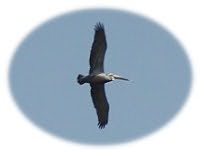 Dignitaries, stamp enthusiasts, conservationists, and many more gathered in Sebastian, Florida, March 14th to celebrate the centennial of Pelican Island National Wildlife Refuge, the first refuge in the United States.
Dignitaries, stamp enthusiasts, conservationists, and many more gathered in Sebastian, Florida, March 14th to celebrate the centennial of Pelican Island National Wildlife Refuge, the first refuge in the United States.
For many stamp collectors it is easy to overlook the significance of some topics depicted on our stamps and through the events held at Pelican Island and in Sebastian we caught a glimpse into the future of conservation and an understanding of the historical significance of the Wildlife Refuge System.
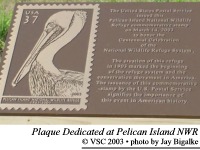
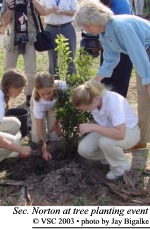 For a special event held at Pelican Island NWR, the U.S. Postal Service provided a special plaque featuring an image of the stamp. Secretary of the Interior Gale A. Norton spoke on keeping the tradition of conservation alive for centuries to come and mentioned First Lady Laura Bush's new program called "Preserve America."
For a special event held at Pelican Island NWR, the U.S. Postal Service provided a special plaque featuring an image of the stamp. Secretary of the Interior Gale A. Norton spoke on keeping the tradition of conservation alive for centuries to come and mentioned First Lady Laura Bush's new program called "Preserve America."
"The creation of this refuge in 1903 marked the beginning of the refuge system and the conservation movement in America," said U.S. Postal Service Chief Operating Officer Patrick R. Donahoe. "The issuance of this commemorative stamp by the U.S. Postal Service signifies the importance of this event in American history." After the plaque dedication, we walked up a trail towards an area where Norton joined local school children in planting a couple of trees. She was then joined by the other dignitaries in the installation of the final plank in the Centennial Boardwalk which leads to the new viewing tower that overlooks Pelican Island. Norton and local school children then participated in a ribbon cutting ceremony that officially opened the Boardwalk. The Boardwalk features the names of all 540 National Wildlife Refuges in the United States from the last established one to the first, Pelican Island. The public then joined Norton in viewing Pelican Island for the first time from the newly-constructed tower.
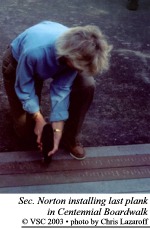 |
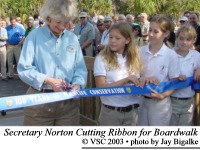 |
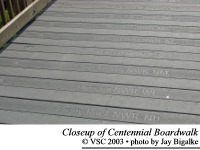 |
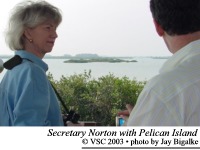 |
 |
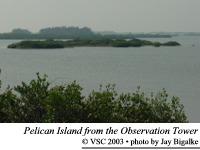 |
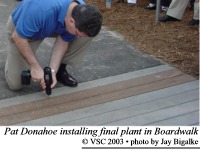 |
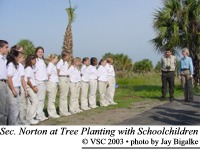 |
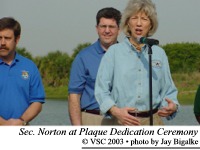 |

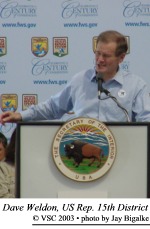
Centennial Commission member and television personlality Jack Hanna then introduced Challenger, a bald eagle and a short film describing the eagle's life. Jernie Talles, a third grader from the local elementary school, sang the National Anthem with an amazingly powerful voice as Challenger flew over the audience.
U.S. Rep. Dave Weldon, M.D. spoke, as did Florida Lieutenant Governor Toni Jennings, who was excited to be at the event: It was her first large-scale event, since it was only her fifth day in office.
Author and Theodore Roosevelt biographer Edmund Morris talked at great length about the numerous great achievements of the president who established the National Wildlife Refuge system.
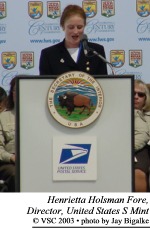 Then Director of the U.S. Mint Henrietta Holsman Fore unveiled a series of four commemorative silver medals and one commemorative bronze medal to mark the 100th Anniversary of the National Wildlife Refuge System. The coins are scheduled to be released later this year.
Then Director of the U.S. Mint Henrietta Holsman Fore unveiled a series of four commemorative silver medals and one commemorative bronze medal to mark the 100th Anniversary of the National Wildlife Refuge System. The coins are scheduled to be released later this year.
"These designs celebrate the priceless natural treasures of our nation, and the legacy of a pioneering, visionary president who a century ago recognized the value of conserving this Nation's precious resources," she said.
The coins feature Roosevelt on the front side while the four different reverses feature a bald eagle, an elk, a salmon, and a canvasback duck.
But Fore was interrupted by applause from protesters in the audience as a plane flew over the ceremony with a banner reading "DON'T DRILL THE ARCTIC REFUGE." Fore commented "Teddy Roosevelt would have appreciated that."
Assistant Secretary of the Interior for Fish and Wildlife and Parks Craig Manson gave very brief remarks which I'm fairly sure was appreciated by most, as the temperature was nearing ninety. One person had passed out.
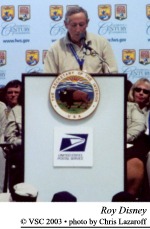
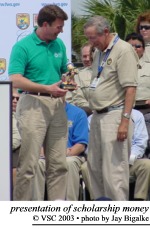 "A large part of my own career was involved with the study of wildlife...although by way of the viewfinder of a 16-millimeter film camera," Walt Disney executive Roy Disney said.
"A large part of my own career was involved with the study of wildlife...although by way of the viewfinder of a 16-millimeter film camera," Walt Disney executive Roy Disney said.
He introduced a film of his Uncle Walt speaking about the importance of conservation, much of which is still true today.
Roy Disney then presented a $100,000 gift that established The Centennial Commission Scholarship Fund for Conservation which is intended to encourage graduate students in conservation and environmental education. In addition to the money, Disney also presented a statue of Jiminy Cricket to the National Fish and Wildlife Foundation.
The "Voices of Liberty" from the Walt Disney World Resort then sang, including "This Land is Your Land."
© 2003 de Vries Philatelic Media